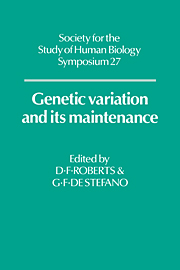Book contents
- Frontmatter
- Contents
- Preface
- Part I Genetic Diversity - Its Dimensions
- Genetic polymorphisms - a widening panorama
- Some implications of improved electrophoresis techniques for population genetics
- HLA variation in the tropics
- Chromosome polymorphism in humans
- Restriction fragment length polymorphisms in the human genome
- Nucleotide sequences, restriction maps, and human mitochondrial DNA diversity
- Mitochondrial DNA variation in eastern highlanders of Papua New Guinea
- The Contribution of polymorphisms in mtDNA to population genetic studies
- Part II Genetic Diversity - Its Origin and Maintenance
- GENETIC DIVERSITY - APPLICATIONS AND PROBLEMS OF COMPLEX CHARACTERS
- Index
Restriction fragment length polymorphisms in the human genome
Published online by Cambridge University Press: 05 March 2012
- Frontmatter
- Contents
- Preface
- Part I Genetic Diversity - Its Dimensions
- Genetic polymorphisms - a widening panorama
- Some implications of improved electrophoresis techniques for population genetics
- HLA variation in the tropics
- Chromosome polymorphism in humans
- Restriction fragment length polymorphisms in the human genome
- Nucleotide sequences, restriction maps, and human mitochondrial DNA diversity
- Mitochondrial DNA variation in eastern highlanders of Papua New Guinea
- The Contribution of polymorphisms in mtDNA to population genetic studies
- Part II Genetic Diversity - Its Origin and Maintenance
- GENETIC DIVERSITY - APPLICATIONS AND PROBLEMS OF COMPLEX CHARACTERS
- Index
Summary
INTRODUCTION
Restriction fragment length polymorphisms (RFLPs) result from DNA base-pair changes that introduce or remove a restriction site, or sequence deletions, additions or rearrangments, that affect the length of DNA between sites. RFLPs promise to be useful in a number of different ways. Their utilisation as ‘genetic signposts’ should eventually permit the saturation of the human genome with evenly-spaced marker loci (White et al, 1985). This new system of markers at the DNA level promises to unify mapping at the cytogenetic and molecular levels, greatly improve the resolution so necessary for accurate gene mapping and linkage studies and give a new perspective on genetic variation. The improved linkage map should provide sufficient markers to localize and diagnose many hitherto undetectable genetic defects and allow the identification of heterozygous carriers.
This article describes a search for RFLPs in the human genome using a random sample of cloned DNA segments. Analysis of the data has permitted a first estimate of heterozygosity in the human genome, an amount large enough to demonstrate the extensive variation which can be exploited in clinical medicine. The clinical applications of recombinant DNA technology to the analysis and diagnosis of human genetic disease are then presented. RFLPs associated either with gene regions or linked DNA segments may permit antenatal diagnosis in cases where it has not proved possible to detect gene defects directly using a cloned gene probe.
- Type
- Chapter
- Information
- Genetic Variation and its Maintenance , pp. 57 - 76Publisher: Cambridge University PressPrint publication year: 1986



